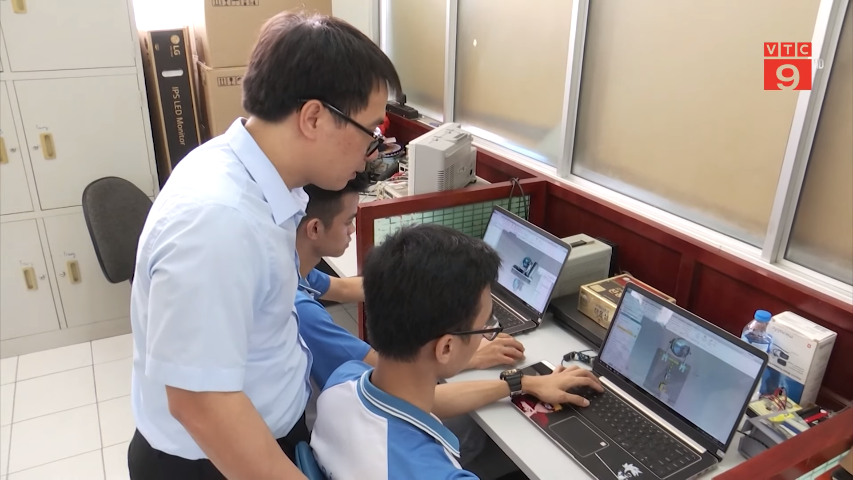
As Vietnam was bracing for the second wave of coronavirus last May, a group of HUST researchers unveiled a “home-made” ventilator which could be ready for industrial manufacturing.
Amid the coronavirus crisis, importing large numbers of ventilators would have been difficult; meanwhile local manufacturers could not ramp up production enough to meet soaring demand, at least not in a short time span. Hence Hanoi University of Science and Technology engineers and researchers decided to design their own.
The mechanical-electronic ventilator BK-Vent has a simple structure and it can be cheaply and quickly built from locally available components, said Associate Professor Vu Duy Hai, who is the leader of the Biomedical Electronic Engineering Center at the university.

Associate Professor Vu Duy Hai (behind) instructs his students to design the ventilator in the laboratory in May 2020. Photo by VTC9
The research team can make up to 500 units a month, helping supply these devices to hospitals where they can help patients affected by the coronavirus. The manufacturing cost per device is estimated to be around one-tenth of currently imported commercial systems on the market.
The Health Ministry estimated Vietnam had a total of 6,000 ventilators last April and the capital of Hanoi, home to nearly 8 million people, had only 300 devices. That meant far more machines would be needed if a major COVID-19 outbreak occurred.
A ventilator can be the difference between life and death for patients facing the acute respiratory effects of the coronavirus.
“BK-Vent is a part of HUST’s contribution to government efforts to fight COVID-19,” said Associate Professor Vu Duy Hai, adding that the device is compact, deployable so it can provide health workers with flexibility in treating patients.

BK-Vent is reported to work in two modes, including continuous positive airway pressure and assist-control mechanical ventilation. The additional smart mode helps deliver the mandatory breaths in synchrony with the patient’s own inspiratory efforts, which is called synchronized intermittent mandatory ventilation for respiratory failure.
The device, developed based on the quality assurance set by the Health Ministry as well as the design guidance by the US-based Association for the Advancement of Medical Instrumentation, has been validated by the Institute of Technology and Health Works whose duty is to assure medical devices available in the country are safe and effective.
Reporting by Dieu Ngoc and My Hanh; and Editing by Hanh Pham.
Newer articles
Older articles
 Hanoi University of Science And Technology And 4...
Hanoi University of Science And Technology And 4...
 HUST promotes partnerships with leading universities in the...
HUST promotes partnerships with leading universities in the...
 HUST co-hosted the 18th GMSARN Conference, fostering...
HUST co-hosted the 18th GMSARN Conference, fostering...
 Strategic Partnership Forges Between Hanoi University Of...
Strategic Partnership Forges Between Hanoi University Of...
 HUST President Pays Visits To Korean Academic & Industrial...
HUST President Pays Visits To Korean Academic & Industrial...
 POSCO TJ Foundation Awarded Scholarship To Hust Students
POSCO TJ Foundation Awarded Scholarship To Hust Students
 HUST advances staff capacity through "EQUIP" Project in...
HUST advances staff capacity through "EQUIP" Project in...
 From adversity to acclaim: The resilient journey of Assoc....
From adversity to acclaim: The resilient journey of Assoc....
 HUST Promotes Business Collaboration In Logistics And...
HUST Promotes Business Collaboration In Logistics And...
 HUST's imprint at Vietnam International Innovation Expo 2023
HUST's imprint at Vietnam International Innovation Expo 2023